Improving Nutrition Information in the Eastern Mediterranean Region: Implementation of Front-of-Pack Nutrition Labelling
Abstract
1. Introduction
2. Methods
- An initial scoping literature review which identified, through PubMed, review articles on nutrition labelling which were published in English after 2000 [13,14,15,16,17,18,20,22,23,24,25,26,27,28,29,30,31,32,33]. Only reviews which included any explicit consideration of front-of-pack nutrition labelling were included. In addition, relevant grey literature—including reports from official bodies such as WHO, the Codex Alimentarius Commission and the European Commission—was identified [19,20,34,35]. Further specific references were identified from these reviews to enable more in-depth exploration of some of the issues highlighted in the discussion section.
- Presentations and discussions during the Technical Consultation in September 2018.
- Information on implementation in the Eastern Mediterranean Region, identified through follow-up communication with experts about ongoing research and with nutrition or food regulatory officials in the relevant countries.
- Are presented on the front of food packages (in the principle field of vision) and can be applied across the packaged retail food supply;
- Comprise an underpinning nutrient profile model that considers the overall nutrition quality of the product and/or the nutrients of concern for NCD;
- Present simple, often graphic information on the nutrient content and/or nutritional quality of products to complement the more detailed nutrient declarations usually provided on the back of food packages [20].
- To provide consumers with nutrition information in a more understandable format, with a view enabling them to make healthier food choices;
- To encourage food manufacturers to develop new products and reformulate their existing products towards healthier food products.
- To improve consumer understanding about the links between the nutrient content of foods and health, particularly for the prevention of NCDs;
- To facilitate health professional advice on nutrition and healthy eating;
- To reduce consumer confusion and deception about food products, particularly in relation to misleading use of health and nutrition claims.
- Effects on consumer understanding of the nutritional quality of foods;
- Effects on consumer purchasing behaviour;
- Changes in the nutritional composition of foods (fat, saturated fat, sugars, and salt levels).
3. Results
3.1. Evidence for Effectiveness of Front-of-Pack Labelling
3.2. Global Implementation of Front-of-Pack Nutrition Labelling
Types of Front-of-Pack Labelling Systems
3.3. Implementation of Front-of-Pack Nutrition Labelling the WHO Eastern Mediterranean Region
- The nutrient-specific traffic light labelling (Islamic Republic of Iran, Kingdom of Saudi Arabia, United Arab Emirates);
- The Nutri-Score summary graded label (Morocco);
- Health or endorsement logos (Abu Dhabi and Tunisia).
3.3.1. Traffic Light Labelling Schemes
3.3.2. Nutri-Score Summary Logo
3.3.3. Health (Endorsement) Logos
4. Discussion
5. Conclusions
Author Contributions
Funding
Acknowledgments
Conflicts of Interest
References
- World Health Organization. Global Status Report on Noncommunicable Diseases 2014; World Health Organization: Geneva, Switzerland, 2014. [Google Scholar]
- Institute for Health Metrics and Evaluation. GBD Compare Data Visualization. Available online: https://vizhub.healthdata.org/gbd-compare/ (accessed on 27 September 2019).
- World Health Organization. Global Strategy on Diet, Physical Activity and Health; World Health Organization: Geneva, Switzerland, 2004. [Google Scholar]
- World Health Organization. Comprehensive Implementation Plan on Maternal Infant and Young Child Nutrition; World Health Organization: Geneva, Switzerland, 2014. [Google Scholar]
- Food and Agriculture Organization of the United Nations; World Health Organization. Second International Conference on Nutrition: Framework for Action; FAO/WHO: Rome, Italy, 2014. [Google Scholar]
- World Health Organization. Global Action Plan for the Prevention and Control of Noncommunicable Diseases 2013–2020; WHO: Geneva, Switzerland, 2013. [Google Scholar]
- WHO Regional Office for the Eastern Mediterranean. Regional Framework for Action on Obesity Prevention 2019–2023; WHO: Cairo, Egypt, 2018. [Google Scholar]
- Codex Alimentarius Commission. Guidelines on Nutrition Labelling (CAC/GL-1985); FAO and WHO: Rome, Italy, 2017. [Google Scholar]
- World Health Organization. Global Nutrition Policy Review 2016–2017; WHO: Geneva, Switzerland, 2018. [Google Scholar]
- Musaiger, A.; Al-Hazzaa, H.; Takruri, H.; Mokhatar, N. Change in nutrition and lifestyle in the Eastern Mediterranean Region: Health Impact. J. Nutr. Metab. 2012, 2012, 436762. [Google Scholar] [CrossRef]
- WHO Regional Office for the Eastern Mediterranean Region. Regional Strategy on Nutrition 2010–2019 and Plan of Action; WHO: Cairo, Egypt, 2011. [Google Scholar]
- World Health Organization. Regional Strategy on Nutrition 2010–2019; WHO Regional Office for the Eastern Mediterranean: Cairo, Egypt, 2009. [Google Scholar]
- Campos, S.; Doxey, J.; Hammond, D. Nutrition labels on pre-packaged foods: A systematic review. Public Health Nutr. 2011, 14, 1496–1506. [Google Scholar] [CrossRef] [PubMed]
- Drichoutis, A.C.; Lazaridis, P.; Nagya, R. Consumers’ use of nutritional labels: A review of research studies and issues. Acad. Mark. Sci. Rev. 2006, 2006, 1. [Google Scholar]
- Volkova, E.; Ni Mhurchu, C. The influence of nutrition labeling and point-of-purchase information on food behaviours. Curr. Obes. Rep. 2015, 4, 19–29. [Google Scholar] [CrossRef]
- Cowburn, G.; Stockley, L. Consumer understanding and use of nutrition labelling: A systematic review. Public Health Nutr. 2005, 8, 21–28. [Google Scholar] [CrossRef] [PubMed]
- Hawley, K.L.; Roberto, C.A.; Bragg, M.A.; Liu, P.J.; Schwartz, M.B.; Brownell, K.D. The science on front-of-package food labels. Public Health Nutr. 2012, 16, 430–439. [Google Scholar] [CrossRef] [PubMed]
- Ni Mhurchu, C.; Gorton, D. Nutrition labels and claims in New Zealand and Australia: A review of use and understanding. Aust. N. Z. J. Public Health 2007, 31, 105–112. [Google Scholar] [CrossRef] [PubMed]
- Codex Committee on Food Labelling. Comments from International Association of Consumer Food Organisations on Proposal for New Work Concerning a Global Standard for Front of Pack Interpretive Nutrition Labelling; Agenda Item 9 FL/43 CRD/17; FAO and WHO: Rome, Italy, 2017. [Google Scholar]
- World Health Organization. Draft WHO Guiding Principles and Framework Manual for Front-of-Pack Labelling for Promoting Healthy Diets; WHO: Geneva, Switzerland, 2019. [Google Scholar]
- Talati, Z.; Egnell, M.; Hercberg, S.; Julia, C.; Pettigrew, S. Consumers’ perception of five front-of-package nutrition labels: An experimental study across 12 countries. Nutrients 2019, 11, 1934. [Google Scholar] [CrossRef] [PubMed]
- Rayner, M.; Wood, A.; Lawrence, M.; Mhurchu, N.M.; Albert, J.; Barquera, S.; Friel, S.; Hawkes, C.; Kelly, B.; Kumanyika, S.; et al. Monitoring the health-related labelling of foods and non-alcoholic beverages in retail settings. Obes. Rev. 2013, 14 (Suppl. 1), 70–81. [Google Scholar] [CrossRef]
- Cecchini, M.; Warin, L. Impact of food labelling systems on food choices and eating behaviours: A systematic review and meta-analysis of randomized studies. Obes. Rev. 2016, 17, 201–210. [Google Scholar] [CrossRef]
- Hersey, J.; Wohlgenant, K.; Arsenault, J.; Kosa, K.; Muth, M. Effects of front-of-package and shelf nutrition labeling systems on consumers. Nutr. Rev. 2013, 71, 1–14. [Google Scholar] [CrossRef] [PubMed]
- Storcksdieck genannt Bonsmann, S.; Wills, J. Nutrition Labeling to Prevent Obesity: Reviewing the Evidence from Europe. Curr. Obes. Rep. 2012, 1, 134–140. [Google Scholar] [CrossRef] [PubMed]
- Crockett, R.; King, S.; Marteau, T.; Prevost, A.; Bignardi, G.; Roberts, N.; Stubbs, B.; Hollands, G.; Jebb, S. Nutritional labelling for healthier food or non-alcoholic drink purchasing and consumption. Cochrane Database Syst. Rev. 2018, 2, CD009315. [Google Scholar] [CrossRef] [PubMed]
- Grunert, K.; Wills, J.; Fernández-Celemín, L. Nutrition knowledge, and use and understanding of nutrition information on food labels among consumers in the UK. Appetite 2010, 55, 177–189. [Google Scholar] [CrossRef] [PubMed]
- Vyth, E. Front-of-pack nutrition label stimulates healthier product development: A quantitative analysis. Int. J. Behav. Nutr. Phys. Act. 2010, 7, 65. [Google Scholar] [CrossRef]
- van Kleef, E.; Dagevos, H. The growing role of front-of-pack nutrition profile labeling: A consumer perspective on key issues and controversies. Crit. Rev. Food Sci. Nutr. 2015, 55, 291–303. [Google Scholar] [CrossRef]
- Talati, Z.; Pettigrew, S.; Neal, B.; Dixon, H.; Hughes, C.; Kelly, B. Consumers’ responses to health claims in the context of other on-pack nutrition information: A systematic review. Nutr. Rev. 2017, 75, 260–273. [Google Scholar] [CrossRef]
- Temple, N.J.; Fraser, J. Food labels: A critical assessment. Nutrition 2014, 30, 257–260. [Google Scholar] [CrossRef]
- Graham, D.J.; Orquin, J.L.; Visschers, V.H.M. Eye tracking and nutrition label use: A review of the literature and recommendations for label enhancement. Food Policy 2012, 37, 378–382. [Google Scholar] [CrossRef]
- Hieke, S.; Taylor, C.R. A critical review of the literature on nutrition labelling. J. Consum. Aff. 2012, 46, 120–156. [Google Scholar] [CrossRef]
- Kelly, B.; Jewell, J. What Is the Evidence on the Policy Specifications, Development Processes and Effectiveness of Existing Front-of-Pack Food Labelling Policies in the Who European Region? Health Evidence Network (Hen) Synthesis Report 61; WHO Regional Office for Europe: Copenhagen, Denmark, 2018. [Google Scholar]
- Codex Committee on Food Labelling Electronic Working Group. Discussion Paper on Consideration of Issues Regarding Front-of-Pack Nutrition Labelling; CX/FL 17/44/7, Agenda Item 7; Codex Alimentarius Commission, FAO and WHO: Rome, Italy, 2017. [Google Scholar]
- World Cancer Research Fund International. Building Momentum: Lessons on Implementing a Robust Front-of-Pack Food Label; World Cancer Research Fund International: London, UK, 2019. [Google Scholar]
- Shangguan, S.; Afshin, A.; Shulkin, M.; Ma, W.; Marsden, D.; Smith, J.; Saheb-Kashaf, M.; Shi, P.; Micha, R.; Imamura, F.; et al. A meta-analysis of food labeling effects on consumer diet behaviors and industry practices. Am. J. Prev. Med. 2019, 56, 300–314. [Google Scholar] [CrossRef] [PubMed]
- Jones, A.; Neal, B.; Reeve, B.; Mhurchu, C.N.; Thow, A.M. Front-of-pack nutrition labelling to promote healthier diets: Current practice and opportunities to strengthen regulation worldwide. BMJ Glob. Health 2019, 4, e001882. [Google Scholar] [CrossRef] [PubMed]
- Neal, B.; Crino, M.; Dunford, E.; Gao, A.; Greenland, R.; Li, N.; Ngai, J.; Ni Mhurchu, C.; Pettigrew, S.; Sacks, G.; et al. Effects of different types of front-of-pack information on the healthiness of food purchases–a randomized controlled trial. Nutrients 2017, 9, 1284. [Google Scholar] [CrossRef] [PubMed]
- Jones, G.; Richardson, M. An objective examination of consumer perception of nutrition information based on healthiness ratings and eye movements. Public Health Nutr. 2007, 10, 238–244. [Google Scholar] [CrossRef]
- Friere, W.; Water, W.; Rivas-Mariño, G.; Nguyen, T.; Rivas, P. A qualitative study of consumer perceptions and use of traffic light food labelling in Ecuador. Public Health Nutr. 2016, 20, 805–813. [Google Scholar] [CrossRef]
- Julia, C.; Hercberg, S. Development of a new front-of-pack nutrition label in France: The five-colour Nutri-Score. Public Health Panor. 2017, 3, 712–725. [Google Scholar]
- Skotarenko, L. The UK’s Voluntary Front of Pack Nutrition Labelling Scheme. In Proceedings of the European Commission Meeting, Brussels, Belgium, 23 April 2018. [Google Scholar]
- Leclerc, E. Leclerc et Marque Repère Confirmed les Résultats Positifs du Nutriscore; Communique de presse: Ivry sur Seine, France, 2018. [Google Scholar]
- Ni Mhurchu, C.; Eyles, H.; Choi, Y. Effects of a voluntary front-of-pack nutrition labelling system on packaged food reformulation: The Health Star Rating in New Zealand. Nutrients 2017, 9, 918. [Google Scholar] [CrossRef]
- Young, L.; Swinburn, B. Impact of the Pick the Tick food information programme on the salt content of food in New Zealand. Health Promot. Int. 2002, 17, 13–19. [Google Scholar] [CrossRef]
- Eckel, R.; Borra, S.; Lichtenstein, A.; Yin-Piazza, S. Understanding the complexity of trans fatty acid reduction in the American diet: American Heart Association Trans Fat Conference 2006: Report of the Trans Fat Conference Planning Group. Circulation 2007, 115, 2231–2246. [Google Scholar] [CrossRef]
- World Health Organization. Tackling NCDS: ‘Best Buys’ and Other Recommended Interventions for the Prevention and Control of Noncommunicable Diseases; WHO: Geneva, Switzerland, 2017. [Google Scholar]
- World Health Organization. Report of the Commission on Ending Childhood Obesity; WHO: Geneva, Switzerland, 2016. [Google Scholar]
- World Health Organization. Proposed Policy Priorities for Preventing Obesity and Diabetes in the Eastern Mediterranean Region. EMRO Technical Publications Series 46; WHO Regional Office for the Eastern Mediterranean: Cairo, Egypt, 2017. [Google Scholar]
- Ni Mhurchu, C.; Volkova, E.; Jiang, Y.; Eyles, H.; Michie, J.; Neal, B.; Blakely, T.; Swinburn, B.; Rayner, M. Effects of interpretive nutrition labels on consumer food purchases: The Starlight randomized controlled trial. Am. J. Clin. Nutr. 2017, 105, 695–704. [Google Scholar] [CrossRef]
- Egnell, M.; Talati, Z.; Hercberg, S.; Pettigrew, S.; Julia, C. Objective understanding of front-of-package nutrition labels: An international comparative experimental study across 12 countries. Nutrients 2018, 10, 1542. [Google Scholar] [CrossRef] [PubMed]
- Azizollaah, Z.; Dinarvand, R.; Hosseini, H. Nutritional traffic light labeling and taxation on unhealthy food products in Iran: Health policies to prevent non-communicable diseases. Iran. Red Crescent Med. J. 2017, 19, e57874. [Google Scholar]
- Tehran Times. ‘Traffic light’ labels to guide Iranians toward healthier food. May 2017, 9:6. Tehran Times. Available online: https://www.tehrantimes.com/news/413178/Traffic-light-labels-to-guide-Iranians-toward-healthier-food (accessed on 27 September 2019).
- National Program for Happiness and Wellbeing, 2019. To promote Healthy Lifestyle and Wellbeing the UAE National Program for Happiness and Wellbeing launches Nutrition Labelling Policy. Available online: https://www.hw.gov.ae/en/news/to-promote-healthy-lifestyle-and-wellbeing-in-the-uae-national-program-for-happiness-and-wellbeing-launches-nutrition-labelling-policy (accessed on 27 September 2019).
- Julia, C.; Etilé, F.; Hercberg, S. Front-of-pack Nutri-Score labelling in France: An evidence-based policy. Lancet Public Health 2018, 3, e164. [Google Scholar] [CrossRef]
- Julia, C.; Péneau, S.; Buscail, C.; Gonzalez, R.; Touvier, M.; Hercberg, S.; Kesse-Guyot, E. Perception of different formats of front-of-pack nutrition labels according to sociodemographic, lifestyle and dietary factors in a French population: Crosssectional study among the NutriNet-Santé cohort participants. BMJ Open 2017, 7, e016108. [Google Scholar] [CrossRef]
- Crosetto, P.; Lacroix, A.; Muller, L.; Ruffieux, B. Nutritional and economic impact of five alternative front-of-pack nutritional labels: Experimental evidence. Eur. Rev. Agric. Econ. 2019. [Google Scholar] [CrossRef]
- Scarborough, P.; Matthews, A.; Eyles, H.; Kaur, A.; Hodgkins, C.; Raats, M.; Rayner, M. Reds are more important than greens: How UK supermarket shoppers use the different information on a traffic light nutrition label in a choice experiment. Int. J. Behav. Nutr. Phys. Act. 2015, 12, 151. [Google Scholar] [CrossRef]
- Ducrot, P.; Julia, C.; Méjean, C.; Kesse-Guyot, E.; Touvier, M.; Fezeu, L.; Hercberg, S.; Péneau, S. Impact of different front-of-pack nutrition labels on consumer purchasing intentions: A randomized controlled trial. Am. J. Prev. Med. 2016, 50, 627–636. [Google Scholar] [CrossRef]
- Abu Dhabi Quality and Conformity Council. Specification for Using Weqaya Food Program (ADS13/2018); Abu Dhabi Quality and Conformity Council: Abu Dhabi, UAE, 2015.
- World Health Organization Regional Office for the Eastern Mediterranean. Nutrient Profile Model for the Marketing of Food and Non-Alcoholic Beverages to Children in the WHO Eastern Mediterranean Region; WHO: Cairo, Egypt, 2017. [Google Scholar]
- AFSSA. Définition de Profils Nutritionnels Pour L’accès aux Allégations Nutritionnelles et de Santé: Propositions et Arguments; Agence Française de Sécurité Sanitaire des Aliments: Paris, France, 2008. [Google Scholar]
- Darmon, N.; Vieux, F.; Maillot, M.; Volatier, J.-L.; Martin, A. Nutrient profiles discriminate between foods according to their contribution to nutritionally adequate diets: A validation study using linear programming and the SAIN, LIM system. Am. J. Clin. Nutr. 2009, 89, 1227–1236. [Google Scholar] [CrossRef]
- Talati, Z.; Pettigrew, S.; Kelly, B.; Ball, K.; Dixon, H.; Shilton, T. Consumers’ response to front-of-pack labels that vary by interpretive content. Appetite 2016, 101, 205–213. [Google Scholar] [CrossRef]
- Kanter, R.; Vanderlee, L.; Vandevijvere, S. Front-of-package nutrition labelling policy: Global progress and future directions. Public Health Nutr. 2018, 21, 1399–1408. [Google Scholar] [CrossRef]
- Rohr, M.; Kamm, F.; Koenigstorfer, J.; Groeppel-Klein, A.; Wentura, D. The Color Red Supports Avoidance Reactions to Unhealthy Food. Exp. Psychol. 2015, 62, 335–345. [Google Scholar] [CrossRef] [PubMed]
- Cabrera, M.; Machin, L.; Arrúa, A.; Curutchet, M.; Giménez, A.; Ares, G. Nutrition warnings as front-of-pack labels: Influence of design features on healthfulness perception and attentional capture. Public Health Nutr. 2017, 20, 3360–3371. [Google Scholar] [CrossRef]
- MP Consulting. Health Star Rating System Five Year Review Draft Report. February 2019. MP Consulting. Available online: http://www.healthstarrating.gov.au/internet/healthstarrating/publishing.nsf/Content/D1562AA78A574853CA2581BD00828751/$File/Health-Star-Rating-System-Five-Year-Review-Draft-Report.pdf (accessed on 27 September 2019).
- Oqali. Déploiment du Nutri-Score: Analyse à Partir des Données Transmises à l’Oqali. Available online: https://www.oqali.fr/content/download/3635/34510/version/1/file/Oqali+2019_Deploiement_du_Nutri_Score_analyse_a_partir_des_donnees_transmises_a_l_Oqali.pdf (accessed on 29 October 2019).
- Van Camp, D.; Souza-Monteiro, D.M.; Hooker, N.H. Stop Or Go? How Is The Uk Food Industry Responding To Front-Of-Pack Nutrition Labels? In Proceedings of the 115th Joint EAAE/AAEA Seminar, Freising-Weihenstephan, Germany, 15–17 September 2010; pp. 580–591. [Google Scholar]
- Jones, A.; Shahid, M.; Neal, B. Uptake of Australia’s Health Star Rating System. Nutrients 2018, 10, 997. [Google Scholar] [CrossRef] [PubMed]
- Thow, A.M.; Jones, A.; Hawkes, C.; Ali, I.; Labonté, R. Nutrition labelling is a trade policy issue: Lessons from an analysis of specific trade concerns at the World Trade Organization. Health Promot. Int. 2017, 33, 1–11. [Google Scholar] [CrossRef] [PubMed]
| Characteristics | Options | Illustrative Examples |
|---|---|---|
| Interpretive or informative provision of information | Interpretive schemes provide information to help consumers understand how healthy/unhealthy a food product is. This is often conveyed through use of colour coding, graphic symbols, or interpretive words (such as ‘high in’ or ‘low in’). |  Health Star Rating system (Australia/New Zealand) |
| Informative schemes (sometimes known as reductive) provide factual information, with no specific judgement or guidance about the nutritional quality of a food product. | 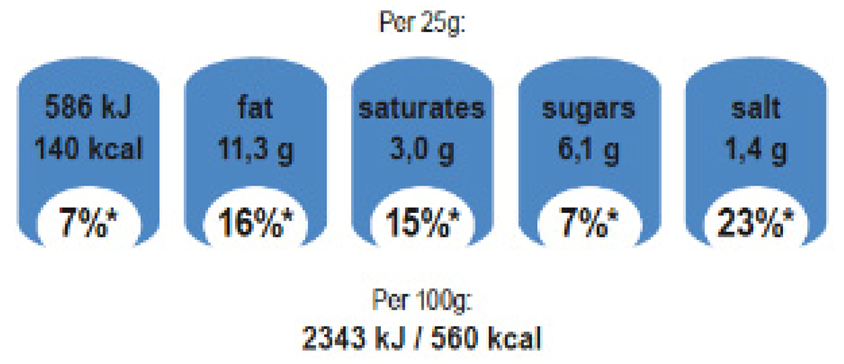 EU food industry Reference Intakes | |
| Hybrid schemes provide a mix of factual information and interpretive elements. | 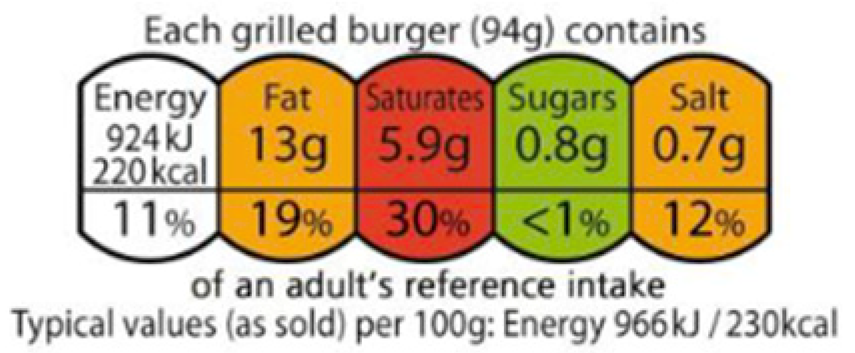 UK traffic light labels combine informative reference intakes and interpretive colour coding | |
| Summary or nutrient based | Summary schemes show an overall indicator of the healthiness of a product, based on a combination of several nutritional criteria. | 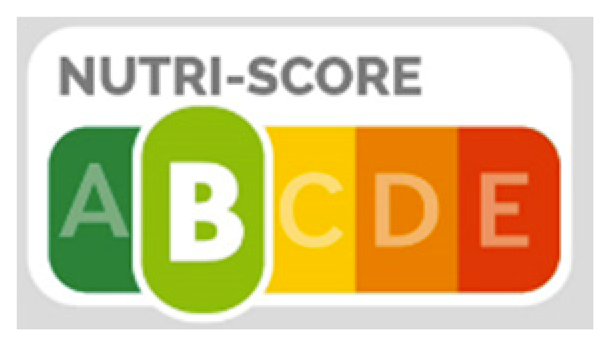 Nutri-Score (France, Belgium, Spain, Germany) |
| Nutrient-specific schemes provide information on a set of nutrients. |  Traffic light labels (Ecuador) | |
| Tone of judgement (for interpretive schemes) | Labels that only identify products of a higher nutritional quality (i.e., positive judgement only). These are often referred to as ‘endorsement logos’ and are sometimes considered to be health claims rather than nutrition labels [22]. |  Nordic Keyhole (Sweden, Denmark, Norway, Lithuania) |
| Labels that provide a graded indicator of nutritional quality or indicate levels of both nutrients/ingredients that are considered healthier and those for which consumption should be limited (positive and negative). | See Nutri-Score and the Health Star Rating | |
| Labels that only identify foods which have high levels of less healthy nutrients/ingredients for which consumption should be limited (negative only). |  Warning labels (Chile) | |
| Mandatory or voluntary implementation | Mandatory schemes require companies to include the specified labels on food packs. Some schemes apply to all foods, others to specific categories. | Mandatory schemes are in place in, for example, in Chile, Ecuador, Finland, Mexico, Sri Lanka, Thailand, and Uruguay. |
| Under voluntary schemes companies can choose whether or not to use the labels. In some cases, government specifies the type of label to be used, although their use is optional. Other voluntary schemes may be driven by industry or other stakeholders, and manufacturers can choose whether or not to use them. | Governments have endorsed voluntary schemes in, for example, Australia, Croatia, Finland, France, Iceland, New Zealand, Norway, Singapore, South Korea, Sweden, and United Kingdom. | |
| Range of nutrients and ingredients included | Schemes vary from those that focus on a nutrient/ingredient alone (e.g., energy or salt) to those which cover a wide range of nutrients/ingredients. Most commonly included components are sodium/salt, energy, total sugars, saturated fat, total fat, trans fatty acids, and added sugars. |
|
| Reference amount for nutrients | Nutrient calculations and/or declarations can be based on: Per 100 g/100 mL Per serving/portion size |
|
| Nature of Information Provided | Summary Indicator/Nutrient Specific | Tone | Examples | Comments |
|---|---|---|---|---|
| Interpretive (providing information as guidance to help consumers understand the relative healthiness of food products) | Summary indicator | Positive | Tunisia: Abu Dhabi:  | Logos which are positive summary indicators indicate healthier foods within categories. These are often referred to as endorsement or health logos (and these are often defined as ‘health claims’ rather than front-of-pack labelling). Tunisia is introducing a health logo label in the form of a tick. A health logo scheme, called Weqaya, has been implemented on a voluntary basis in Abu Dhabi since 2015. |
| Positive and negative | Under development in Morocco: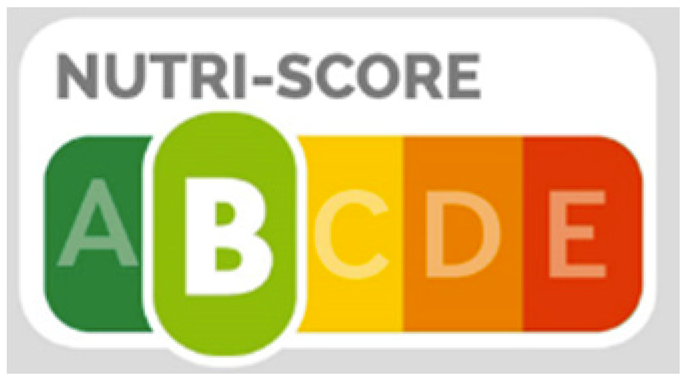 | Summary indicators which cover both positive and negative elements give an overall rating of how healthy a food is. Morocco is conducting research studies to explore implementation of one summary indicator, Nutri-Score, under the Moroccan national 2017–2021 action plan for reducing consumption of salt, sugar and fat, and the national programme of nutrition. | ||
| Nutrient specific | Positive | In general, these are health claims, rather than nutrition labels. | ||
| Positive and negative | Islamic Republic of Iran: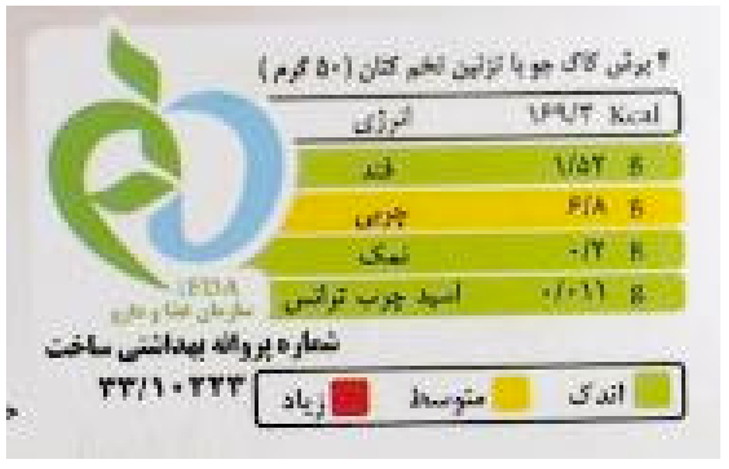 Kingdom of Saudi Arabia: 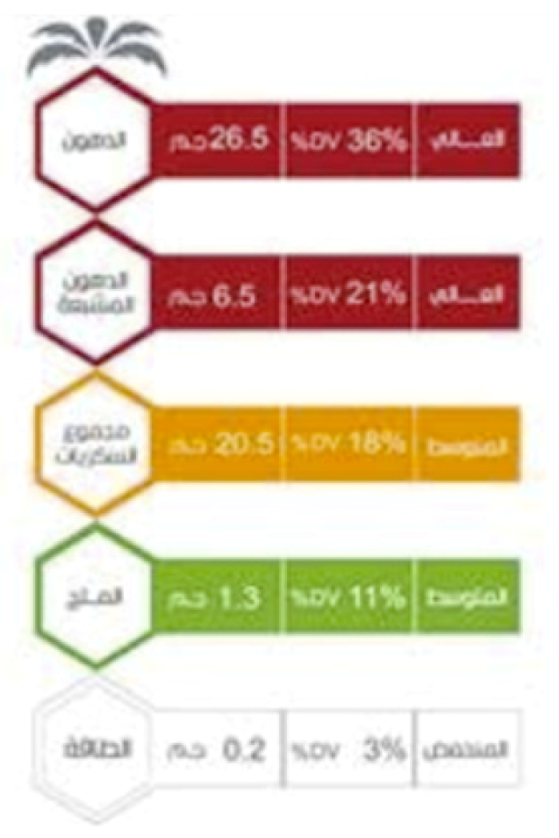 | These schemes apply traffic light colour coding (red, amber, green) to several nutrients to indicate the relative healthiness of those nutrient levels. Iran introduced voluntary traffic light labels in 2014, and these have been mandatory since 2016. The Saudi Food and Drug Authority introduced traffic light labelling in 2018, initially on a voluntary basis. Implementation of traffic lights from 2020 has also been announced in the United Arab Emirates, initially on a voluntary basis, but becoming mandatory by 2022. | ||
| Negative | Nutrient specific negative labels are “warning labels”, as implemented in, for example, Chile. | No implementation of warning labels identified in the Eastern Mediterranean Region. | ||
| Informative (provide factual information, with no guidance on interpretation) | Nutrient specific | These include labels which show the percentage of guideline daily amounts of particular nutrients provided by the food. They do not include any colour-coding or wording to help consumers interpret the information. | No implementation of government-led schemes which only provide such information has been identified in the Eastern Mediterranean Region | |
| Type of Front-of-Pack Label | Strengths | Weaknesses |
|---|---|---|
| Traffic light labelling |
|
|
| Nutri-Score |
|
|
| Health or endorsement logos |
|
|
© 2020 by the authors. Licensee MDPI, Basel, Switzerland. This article is an open access article distributed under the terms and conditions of the Creative Commons Attribution (CC BY) license (http://creativecommons.org/licenses/by/4.0/).
Share and Cite
Al-Jawaldeh, A.; Rayner, M.; Julia, C.; Elmadfa, I.; Hammerich, A.; McColl, K. Improving Nutrition Information in the Eastern Mediterranean Region: Implementation of Front-of-Pack Nutrition Labelling. Nutrients 2020, 12, 330. https://doi.org/10.3390/nu12020330
Al-Jawaldeh A, Rayner M, Julia C, Elmadfa I, Hammerich A, McColl K. Improving Nutrition Information in the Eastern Mediterranean Region: Implementation of Front-of-Pack Nutrition Labelling. Nutrients. 2020; 12(2):330. https://doi.org/10.3390/nu12020330
Chicago/Turabian StyleAl-Jawaldeh, Ayoub, Mike Rayner, Chantal Julia, Ibrahim Elmadfa, Asmus Hammerich, and Karen McColl. 2020. "Improving Nutrition Information in the Eastern Mediterranean Region: Implementation of Front-of-Pack Nutrition Labelling" Nutrients 12, no. 2: 330. https://doi.org/10.3390/nu12020330
APA StyleAl-Jawaldeh, A., Rayner, M., Julia, C., Elmadfa, I., Hammerich, A., & McColl, K. (2020). Improving Nutrition Information in the Eastern Mediterranean Region: Implementation of Front-of-Pack Nutrition Labelling. Nutrients, 12(2), 330. https://doi.org/10.3390/nu12020330






